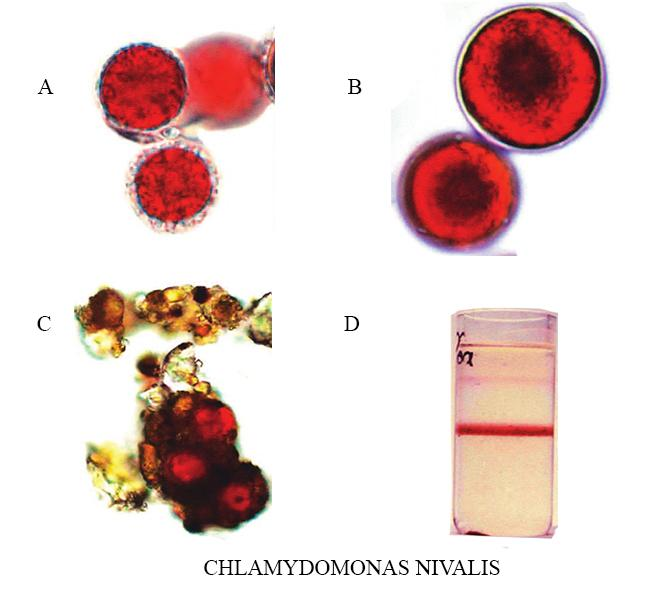Answer
390.9k+ views
Hint: This unicellular life form is an individual from the assorted green growth Division Chlorophyta (Order Volvocales), and contains a brilliant red carotenoid color notwithstanding chlorophyll. In contrast to most types of new water green growth, it is cryophilic (cold-adoring) and flourishes in freezing water.
Complete answer:
Chlamydomonas nivalis is a unicellular red-shaded photosynthetic green alga that is found in the snowfields of the alps and polar areas everywhere on the world. They are one of the principle green growth answerable for causing the wonder of watermelon day off; patches of snow seem red or pink.
Additional Information: In the high mountain scopes of the western United States, at any rate, 60 unique types of snow green growth have been recognized, yet a couple of sorts have been accounted for from the Sierra Nevada. One of the most well-known types of snow green growth in California, and the one answerable for a pink day off, Chlamydomonas nivalis. Its logical family name, nivalis, is from Latin and alludes to day off. During pre-summer and summer, elevated snowbanks are regularly hued wonderful shades of red by a heap of algal cells. The focuses or "sprouts" may stretch out to a profundity of 25 centimeters (10 inches). Each round cell is around 30 micrometers in width, around multiple times the breadth of a human red platelet. It has been assessed that one teaspoon of dissolved snow may contain in excess of 1,000,000 cells of snow green growth.
So the correct answer is red.

Note: Compacting the snow expands the thickness of the red cells and elevates the shading. In some cases, the green growth aggregate in shallow miseries in the snow called sun cups. Since the dim red color retains heat, the cells liquefy their way into the day off, extending the sun cups and quickening the softening pace of snow banks and icy masses. Snow green growth is not generally limited to locales of the never-ending day off, in the high piles of southern California where there is a finished dissolving of snow each midyear.
Complete answer:
Chlamydomonas nivalis is a unicellular red-shaded photosynthetic green alga that is found in the snowfields of the alps and polar areas everywhere on the world. They are one of the principle green growth answerable for causing the wonder of watermelon day off; patches of snow seem red or pink.
Additional Information: In the high mountain scopes of the western United States, at any rate, 60 unique types of snow green growth have been recognized, yet a couple of sorts have been accounted for from the Sierra Nevada. One of the most well-known types of snow green growth in California, and the one answerable for a pink day off, Chlamydomonas nivalis. Its logical family name, nivalis, is from Latin and alludes to day off. During pre-summer and summer, elevated snowbanks are regularly hued wonderful shades of red by a heap of algal cells. The focuses or "sprouts" may stretch out to a profundity of 25 centimeters (10 inches). Each round cell is around 30 micrometers in width, around multiple times the breadth of a human red platelet. It has been assessed that one teaspoon of dissolved snow may contain in excess of 1,000,000 cells of snow green growth.
So the correct answer is red.

Note: Compacting the snow expands the thickness of the red cells and elevates the shading. In some cases, the green growth aggregate in shallow miseries in the snow called sun cups. Since the dim red color retains heat, the cells liquefy their way into the day off, extending the sun cups and quickening the softening pace of snow banks and icy masses. Snow green growth is not generally limited to locales of the never-ending day off, in the high piles of southern California where there is a finished dissolving of snow each midyear.
Recently Updated Pages
In a flask the weight ratio of CH4g and SO2g at 298 class 11 chemistry CBSE

In a flask colourless N2O4 is in equilibrium with brown class 11 chemistry CBSE

In a first order reaction the concentration of the class 11 chemistry CBSE

In a first order reaction the concentration of the class 11 chemistry CBSE

In a fermentation tank molasses solution is mixed with class 11 chemistry CBSE

In a face centred cubic unit cell what is the volume class 11 chemistry CBSE

Trending doubts
Which are the Top 10 Largest Countries of the World?

Difference Between Plant Cell and Animal Cell

Give 10 examples for herbs , shrubs , climbers , creepers

Fill the blanks with the suitable prepositions 1 The class 9 english CBSE

Difference between Prokaryotic cell and Eukaryotic class 11 biology CBSE

Change the following sentences into negative and interrogative class 10 english CBSE

Write a letter to the principal requesting him to grant class 10 english CBSE

Name 10 Living and Non living things class 9 biology CBSE

Black foot disease is caused by the pollution of groundwater class 12 biology CBSE



